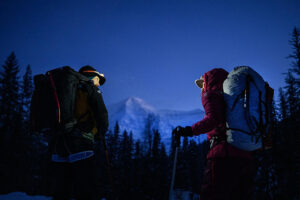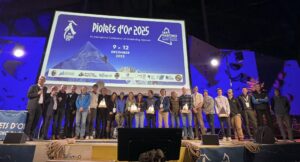A snapshot of their tent turned out to be an inspired move for Czechs Zdenek Hak and Jaroslav Bansky. They were on an expedition to Nepal’s 6,030m Kangchung Shar in 2021, when they photographed their campsite. Weeks later, back home, they noticed a beautiful west face in a corner of the image.
It belonged to Chumbu, an unclimbed 6,859m peak previously attempted by Korean and French teams. The French climbed the southwest pillar in 2016 but didn’t reach the main summit.

The West Face of Chumbu. Photo: Hak & Bansky/Totaloutdoor.cz
Dengue woes
The pair eventually added Petr Kejklicek and Radoslav Groh to the team. Groh had been Marek Holecek‘s partner on Baruntse in 2021. A fifth member, Juraj Koren of Slovakia, planned to paraglide from the summit but was stricken by dengue and never began the climb.
He wasn’t the only dengue victim on the team. Carried by mosquitoes, the disease was rampant in Nepal this wet fall. It affected several of them while they were acclimatizing on a 5,000m peak near Thame, in the Khumbu Valley. It hit Hak and Koren especially hard.
At first, it looked like Hak too would have to bow out. But after some rest, he recovered sufficiently to join his partners later on the Ngozumpa Glacier, in Gokyo. (Here, Gelje Sherpa also led a 2021 attempt on Cho Oyu.)
Hak crossed the broken glacier to base camp in two days. Once there, he learned that a stricken Koren had been airlifted out with dengue.
The remaining foursome climbed in pure alpine style, with no previous information about the route. Some acclimatized up nearby rocky faces, while Bansky and Groh climbed to a col on Changri La to scope out their planned descent line.

Camp at the base of the face. Photo: Zdenek Hak
The climb
Although still weak, Hak joined the others as they set off toward the face via the Gaunara Glacier. They camped under an overhanging rock at the foot of the wall, at approximately 5,700m, then started climbing the following morning, in good conditions.
They began moving up steep ice fields, passing left of a maze of seracs that crossed the face. That night, they were lucky enough to find a comfortable ice cave to sleep in. By the following morning, they felt rested and optimistic, even expecting to reach the summit that day. But they missed the route up the snow and ice gullies and found themselves at a dead end.

Difficult progress on unstable, vertical snow. Photo: Zdenek Hak
“Groh dislodged huge chunks of snow and ice at us,” Hak recalled. “One piece even knocked Peter and me completely off the wall. We were both hanging just by the deadman.”
Eventually, Bansky and Groh, who led the way, managed to rappel down from the dead end by sacrificing two precious ice screws. Hak tried another line to the left but had no better results. Then Groh led again, struggling in vertical, unstable snow, “secured only by two miserable deadmen and our bodies,” wrote Hak.
The summit
Painstakingly they managed to gain altitude, and by the end of the day, they had reached the peak’s shoulder. Exhausted, they set up their third bivouac there.

The heart of the Himalaya from Chumbu. Photo: Zdenek Hak
That night, the temperature went down to -25ºC, so they waited for the sun before finishing the last 80m to the summit the following morning.
“Just below the highest point, [Groh and Bansky] handed the lead over to me. So I had the chance to be the first person in the world to look around from the top of Chumbu,” said Hak.
It was 9 am on a clear, windless day. They spent half an hour on the summit. Now they had only the descent left. Only.

Left to right, Hak, Bansky, Kejklicek, and Groh on the top of Chumbu. Photo: Hak
The descent
“Hard work awaited us in unfamiliar and difficult terrain,” Hak wrote. “For the first 300 vertical metres, we waded down in places up to our knees in an unpleasant crust. Then we had to go uphill again on a razor-sharp ridge.”
Bansky and Hak tried to find an alternative to the vertiginous ridge but found nothing. Back on the ridge, following Groh and Kejklicek, Hak discovered that he was too heavy for the steep snow to hold him, so he had to rope up.
Eventually, the climbers rappelled to a glacial plateau. But after crossing it, they had to return to the ridge, now heading southeast. “Numerous vertical snow towers stopped our progress and we had to wait for the snow to freeze overnight,” Hak said.

An awesome campsite during the descent, with views of Pumori, Everest, Lhotse, and Nuptse. Photo: Zdenek Hak
“We camped in a spot where the ridge widened before getting sharp again,” Hak wrote. “The views of the Pumori, Everest, Lhotse, and Nuptse were phenomenal!”
The next morning, the ridge soon became impossible to follow, That’s when the team got creative.
“We threw Groh over the ridge and used him as an anchor from which we rappelled into a kind of rock window,” Hak said. “Groh then used a buried ski pole and in no time rappelled to us…One pitch after another, we followed the same routine.”

Radoslav Groh on the West Face of Chumbu. Photo: Zdenek Hak
Bitter cold turned into sweltering heat as the day wore on, but the climbers continued rappelling until they finally landed on the glacier.
“Relief drained us of the last remnants of our energy,” admitted Hak. “We sat on stones and were unable to move further. It was over!”
The achievement
Kejklicek was frostbitten, but helicopters could not operate because of the strong wind. They had to walk eight hours to Lobuche village. Hak thought that a shortcut across a frozen lake was a good idea until he sank in ice water up to his knees, in the dark at -10ºC.
Starting to feel frostbitten too, Hak ran and reached Lobuche at 10 pm with Kejklicek. Their two partners showed up the following morning. Airlifted to the hospital in Kathmandu from Lobuche, the two climbers met up with Juraj Koren. He was still in town, recovering from dengue.

Celebration time at Kathmandu’s Czech Pub. Photo: Subin Thakuri
They named the route ‘The last flight of the Falcon’, in memory of Polish mountain guide and friend Andrzej Sokolowski. He and his wife died together in September in a snowboarding accident.

Topo of the new TD+ route, ‘The flight of the Falcon’. Photo: Zdenek Hak
This story is based on Zdenek Hak’s report in Totaloutdoor.cz






